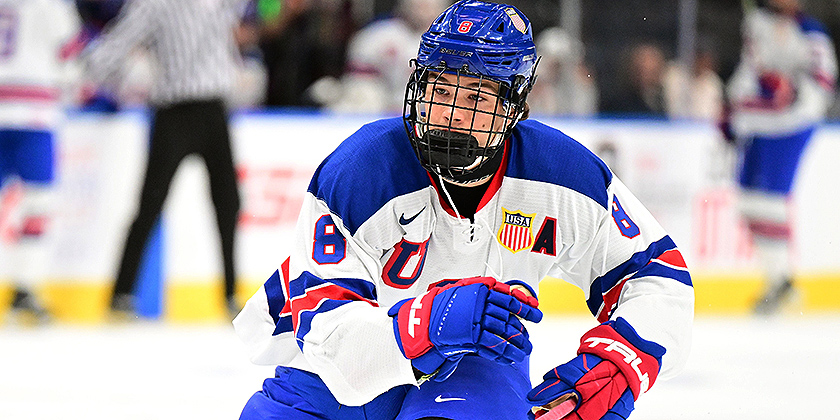
Teddy Mutryn (C, R, 6’1″, 207, Chicago Steel and USNTDP U18, 02/16/2007, Boston College)
Teddy Mutryn is a thick, right-shot winger with a physically mature frame and developing power-forward identity. Splitting time between the Chicago Steel and the U.S. National U18 Team against USHL competition, Mutryn has shown flashes of NHL traits with his strength around the net, puck protection, and scoring touch in tight. He plays in all three zones, contributes on both special teams, and projects as a potential bottom-six NHL winger with finishing upside and net-front utility. However, his current inefficiencies in puck management, acceleration, and decision-making limit his projection without continued improvement.
Case For Drafting Mutryn:
Mutryn’s goal-scoring resume stands out. He has 17 goals in 47 games this season, with 14 coming from within five feet of the net. This indicates high-end situational awareness, a willingness to battle at net front, and the hand strength to finish off second chances. His ability to score in traffic, maintain body position, and outmuscle defenders below the dots is translatable.
He offers versatility — playing wing primarily but with experience at center — and has shown competence on both special teams. On the PK, he reads the play well and uses his size to take away time and space, while on the power play, he provides a net-front presence. His skating is solid for his size, and while not a burner, he builds speed effectively over distance with a powerful stride.
Mutryn averages 2.0 Grade “A” scoring chances per game and converts 14% of them — an encouraging figure that could rise with continued development of his release and one-timer. He has shown he can protect the puck and draw defenders to him, opening space for teammates. His 0.64 completed passes per game that lead directly to Grade “A” chances is above average and speaks to his offensive reads in the offensive zone.
He blocks 0.35 shots per game and recovers 1.77 loose pucks after shots, showing good anticipation and understanding of where plays are going — both important translatable habits to higher levels.
Case Against Drafting Mutryn:
Despite his size, Mutryn’s physical metrics fall short. He wins only 50% of his 50/50 puck battles in the USHL — a red flag considering he’s consistently playing against opponents who are smaller and less physically mature (USHL average forward is 5’11”, 175 lbs). His impact should be greater given his listed 6’1″, 207-lb frame.
He also gives as many hits as he receives (0.95 each per game). If he’s not able to impose his will at the USHL level physically, projecting him as a power forward at the NHL level becomes far more speculative.
Puck management is a significant concern. He completes just 81% of his passes and averages 6 giveaways per game — a glaring number for a player with second-line minutes and power play deployment. This suggests a tendency to rush or force plays rather than simplify and extend possession. Similarly, his 2.9 takeaways per game is low given his size, usage, and deployment — pointing to a lack of defensive disruption.
Projection & Development Path:
Mutryn has legitimate pro habits around the crease, a heavy frame, and can be deployed in a variety of situations. He profiles as a long-term bottom-six NHL winger with goal-scoring upside and potential to kill penalties. To reach that projection, he must:
Improve puck protection and lower his giveaway rate
Become more consistent and punishing physically
Increase win ratio in 50/50 puck battles
Tighten reads and simplify his play at pace
He will benefit greatly from an NCAA development model (Committed to Boston College). A 4 year NCAA track would allow him to round out his game, build explosiveness, and play a more complete 200-foot game at a faster pace.
NHL Projection:
Middle-six potential if he cleans up puck management; more realistically a 4th-line, north-south winger with power play net-front potential.
Draft Recommendation:
5th–6th Round Grade
Mutryn brings enough tools — size, goal-scoring ability in tight, and versatility — to warrant a mid-to-late round pick, but the question marks around puck control, physical consistency, and processing speed at pace leave his upside limited unless continued development occurs. Recommend drafting as a long-term project with a specific development plan focused on improved stride and recovery, puck protection — puck management.
Photo credit: Dan Hickling/Hickling Images
